Email Newsletter
Receive free lesson plans, printables, and worksheets by email:

Printable Worksheets On Plants
Plants can carry out the process of photosynthesis. This is a chemical reaction that provides food for plants. Could you imagine if we could activate the process of photosynthesis within our bodies? It would bring a whole new meaning to dining outdoors! These worksheets help students understand key vocabulary and concepts within the plant family.
- Acrostic Poem
- Bank On It!
- Comparing Plant And Animal Cells
- Do The Research!
- Group Creative Writing
- If I Were A.... ?
- Landscape Writing Paper
- Money Plants Writing Paper
- Plant and Animal Cell Worksheets
- Reading Comprehension
- Venn Diagram: Comparing Flowering Plants
- Vocabulary Quiz
- Vocabulary List & Definitions
- Word Search
Teacher Resources Related to Plants
- Botany Lesson Plans
- Botany Web Sites For Science Teachers
- Plant Life Teaching Resources
Plant Bulletin Boards Icons
- Green House
- Ocean Life 2
- Spider Plant
All About Plants
Plants are an essential resource for the planet and all living things. This article will cover the basic definition of plants, the importance of plants, the seven basic parts of a plant, the stages of a plant life cycle, tips on caring for plants, and the benefits of keeping plants. So, keep reading to find out all about plants.
The Basic Definition of Plants and Their Importance
A plant is a multicellular organism or living thing that grows in land or water. Plants are found in adverse climatic areas, from hot, sandy deserts to snowy mountain slopes –they can survive almost anywhere on the planet. Plants turn the light from the sun into food in photosynthesis. From giant trees to small patches of mosses, they exist in many sizes.
In addition to being a source of food, shelter, fiber, fuel, and herbal medicine, they also absorb carbon dioxide, which is harmful to humans. Plants are essential for maintaining a balance in nature. These organisms also provide food, shelter, and a natural habitat for many animals.
The Seven Basic Parts of a Plant
Here are the seven basic parts of plants that you should know about!
1. Seeds - Plants grow to form seeds. Seeds contain plant material that develops into a planet. The plant material contained in seeds is referred to as an embryo. Seeds have a protective coating and contain sufficient food for the baby plant until it is big enough to make its food from sunlight. The food included in seeds is referred as Cotyledons.
2. Roots - Roots are the most essential parts of a plant as they help anchor the plant in the soil. Roots also protect the plants from being damaged due to strong wind. Roots work to absorb all the essential nutrients and water from the soil to help the plant grow.
3. Stem - Stems are like the backbone of a plant and provide support to the upper part of the plant. Stems also work as a transport to move water and essential nutrients across plants. In the case of some species like cacti, bananas, and celery, photosynthesis takes place in the stem.
4. Leaves - Photosynthesis typically occurs in the leaves of most plants. The leaves are where the food for the organisms is produced. Leaves contain a green substance called chlorophyll that captures energy from the sunlight and uses that power to convert water and carbon dioxide into oxygen and food for the plants.
5. Flowers - The reproductive parts of plants are called flowers. Flowers attract bees, birds, and insects as they are fragrant. Here are the four basic parts of flowers:
- Petals - Stamen - Pistil - Sepals
After pollination and fertilization takes place in flowers, seeds are produced in the flower's ovary.
6. Fruits - Fruits are sweet and fleshy products of a plant or tree containing seeds and attracting animals to eat them, which helps in dispersing seeds for more plants to grow.
The Four Stages of Plant Life Cycle
There are four basic stages of a plant lifecycle which are described as follows:
1. Seed - The first stage of the plant lifecycle is when the seed gets planted into the soil and receives water and sunlight. Seeds are either planted in the ground or fall from the plants and settle in the soil.
2. Germination - After three to four days, the germination process takes seed, which means that the seed's hard shell softens, splits, and roots begin to grow. Seeds contain all the essential nutrients that a plant requires to grow. Roots grow downwards, while the shoots of the plant grow upwards.
3. Seedling - After a week of this process, shoots appear above the soil, after which leaves start to grow. If the plants receive sufficient water and nutrient, the stems grow taller and wider.
4. Growth Cycle- Buds are formed as the seedling grows, which then turn to unfold into petals. Once the plant is big and tall, it reaches the maturity stage, and flowers begin to blossom.
5. Seeds fall - Seeds fall from the fully blossomed flowers back into the soil for the plant cycle to begin again.
Tips on How to Care for Plants
Like all living things, plants require care and attention to survive. Here are some tips on caring for them:
1. Choosing the right pot is the first toward caring for your plant. It should not be too big or too small for the plant.
2. Use fertilized soil or add natural fertilizers like crushed egg shells to allow the plants to receive sufficient nutrients to grow.
3. Ensure that you water the plant regularly. Don't underwater or overwater your plant.
4. Give your plant plenty of sunlight. If you have it indoors, place them next to the windows where there is abundant sunlight.
5. Reading about your plant helps as it allows you to understand how much water and sunlight it needs to survive.
Benefits of Having Indoor Plants
Having indoor plants is not just a healthy activity, but it also comes with some added perks. Here are some of the benefits of keeping indoor plants.
1. Air-Cleaning Properties - They improve the quality of the air you breathe, which directly impacts your overall health. Fun fact: due to the air-cleaning properties of plants, researchers are now looking for ways to improve air quality in air-tight sealed spacecraft.
2. Reduce Stress and Improve the Mood - According to research, plants help reduce stress and put you in a better mood. Our connection to living things is in our DNA, which means that we are naturally drawn to seek connection with other forms of life on the planet, like animals and plants.
3. Boost Your Productivity - Caring for plants is a therapeutic, productive activity. They require to be watered and taken care of regularly, which adds a healthy exercise to your daily routine and allows you to be more effective.
4. Improves Sleep - Research suggests that indoor plants with green leaves, like dracaenas, improve the quality of our sleep, so it is best to have them in your bedroom.
- Grades 6-12
- School Leaders
Don't Miss the Grand Prize: A $2,500 Office Depot/OfficeMax Card!
Every product is independently selected by (obsessive) editors. Things you buy through our links may earn us a commission.
33 Free Plant Life Cycle Activities That Grow the Learning Fun
Cultivate a love of the natural world.
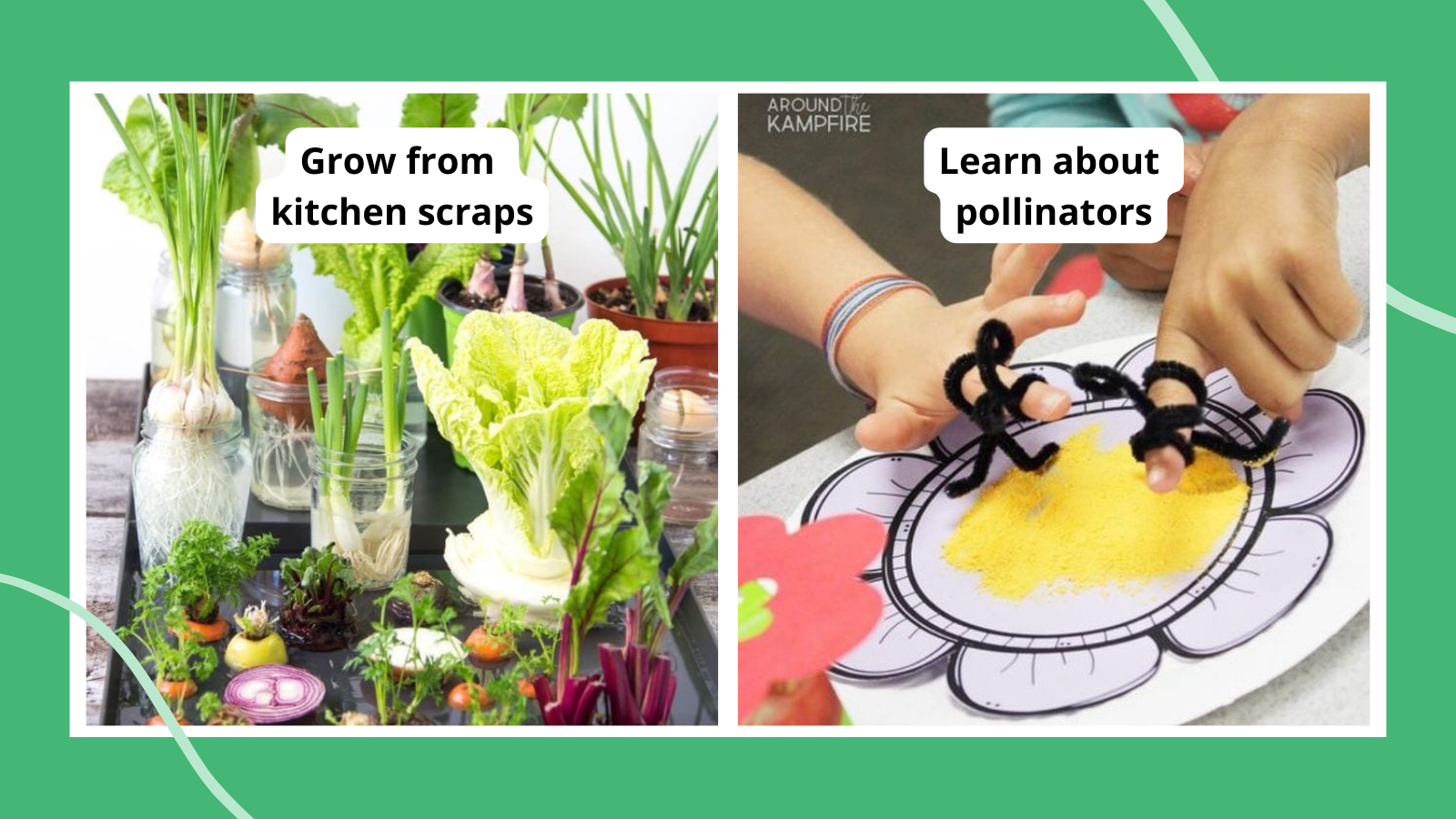
Looking for creative plant life cycle activities? We have 33 fun and free teaching ideas including videos, hands-on experiments, printables, and more. Your students will love learning about the plant life cycle and how they can help plants grow and thrive.
1. Read The Tiny Seed by Eric Carle
Eric Carle’s The Tiny Seed is one of the best plant life cycle references for little ones. Listen to it for story time, then use the book as a springboard for further activities.
2. Start with an anchor chart
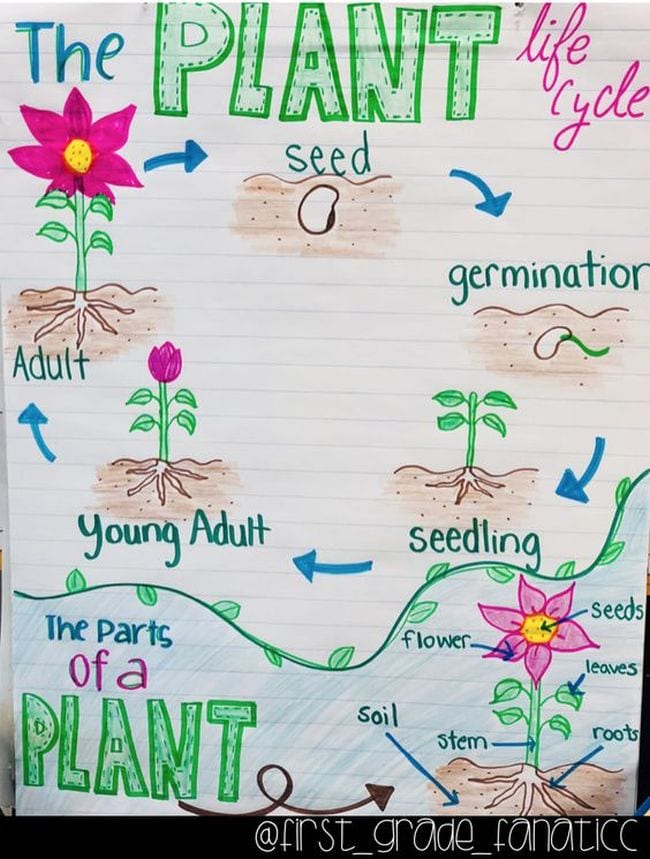
Have your students help you create an anchor chart of the plant life cycle, then post it in your classroom for reference as you do some hands-on learning.
Learn more: Plant Anchor Chart at First Grade Fanatic on Pinterest
3. Discover how a seed grows into a plant
If you need a strong video to kick off a lesson about seeds or the plant life cycle, this video is a good place to start.
4. See it grow in slow-mo
Check out this time-lapse video that shows the fascinating details of how a plant’s root system grows quickly over the course of a few days. After this, kids will definitely want to see it happen for themselves!
5. Spin a plant life cycle wheel
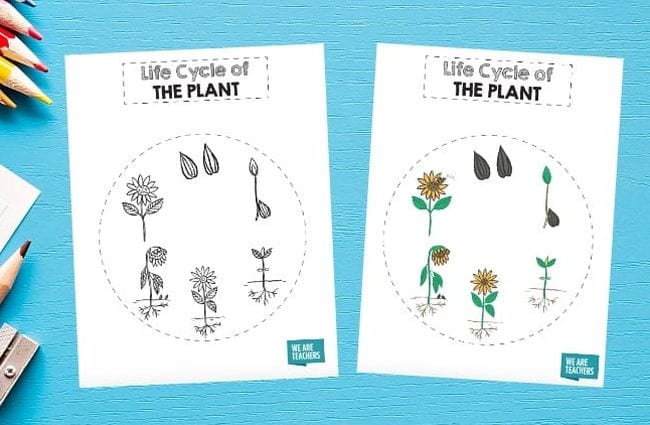
Grab the free printables and watch this video to learn how to turn them into an interactive learning tool with paper plates.
Learn more: Plant Life Cycle Printables at We Are Teachers
6. Germinate in a jar
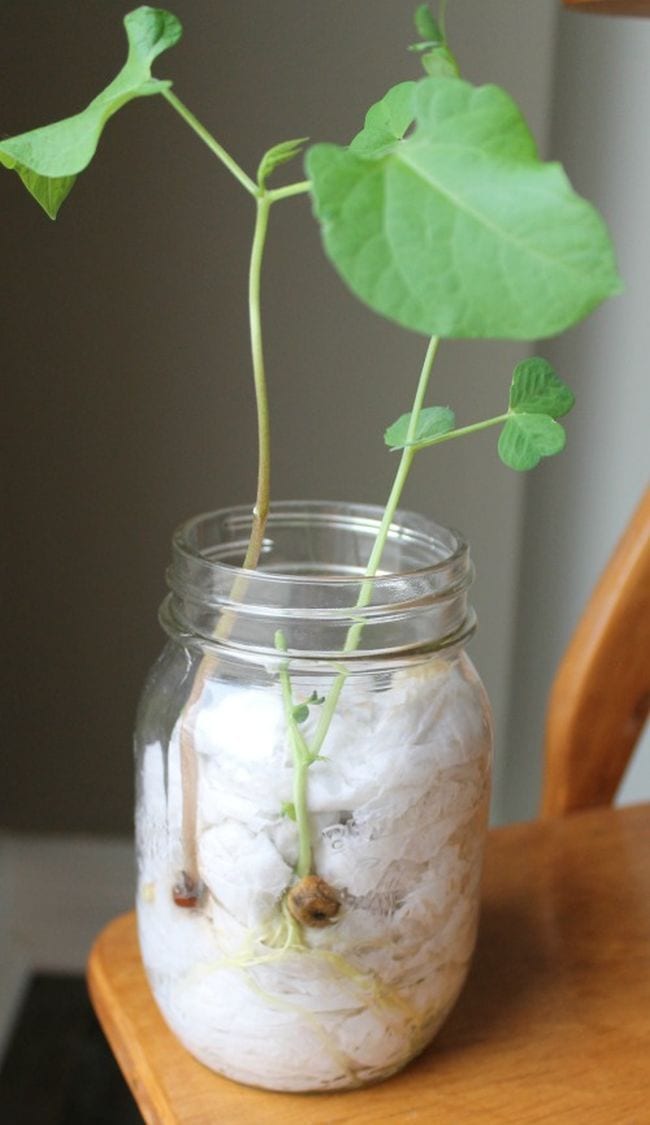
This is one of those classic plant life cycle activities every kid should try. Grow a bean seed in wet paper towels up against the side of a glass jar. Students will be able to see the roots form, the sprout take off, and the seedling reach for the sky!
Learn more: Germination Jars at How Wee Learn
7. Build a sprout house
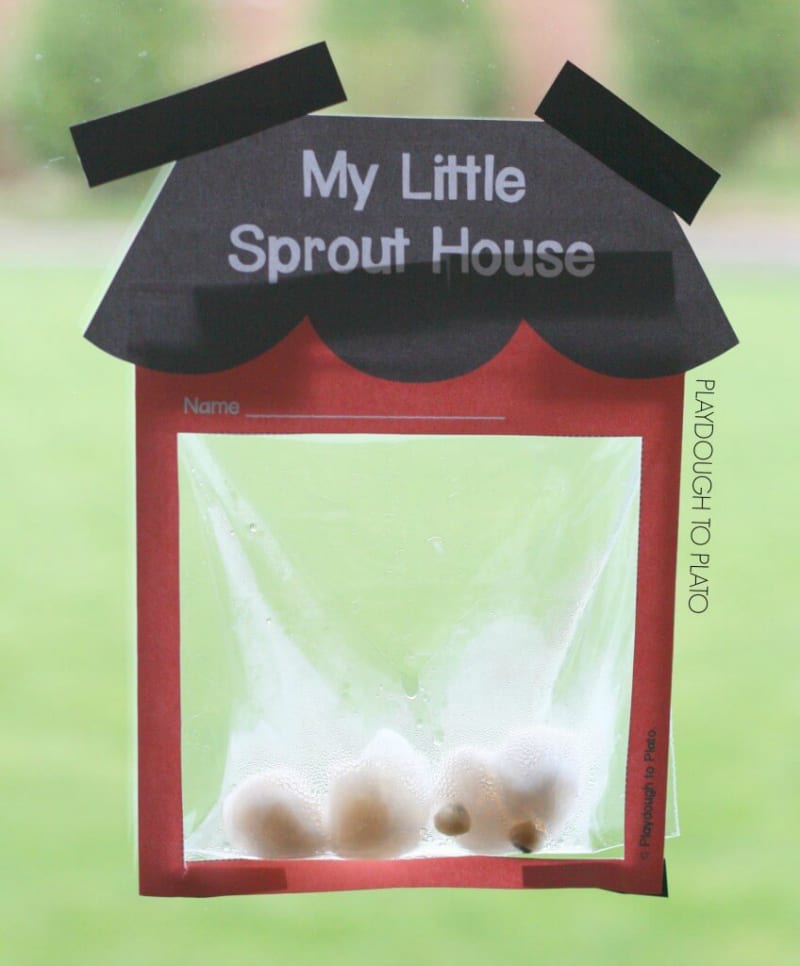
This is another great idea for watching seeds sprout. For this one, all you need is a sunny window (no soil required).
Learn more: Sprout House at Playdough to Plato
8. Sort sprouted seeds
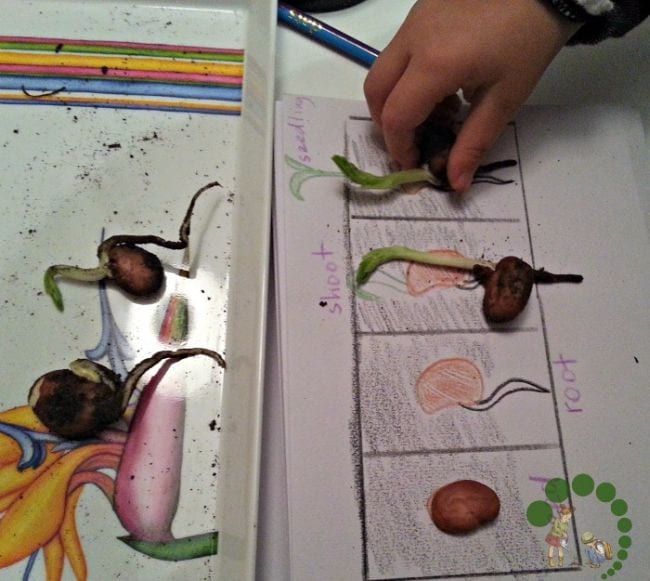
As your seeds begin to grow, sort and draw the various stages. Little ones can learn simple vocab like root, sprout, and seedling. Older students can tackle advanced terms like cotyledon, monocot, and dicot.
Learn more: Seed Sorting at Montessori Nature
9. Conduct a plant dissection experiment
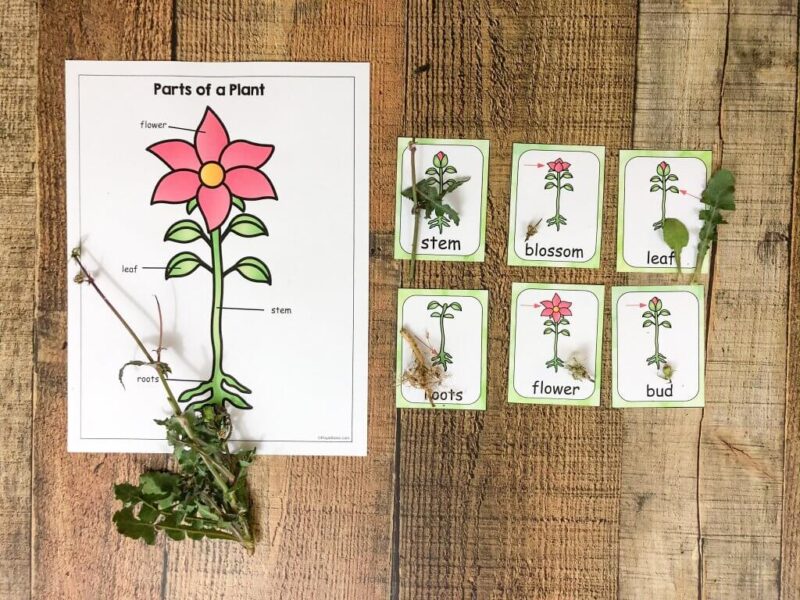
Using magnifying glasses and tweezers, students will dissect flowers or food plants to learn the different parts. Handy tip: You don’t need separate plants for every student. Bring in one plant and give each student a different part.
Learn more: Plant Dissection at Royal, Baloo, and Logi Bear Too
10. Create living art with cress
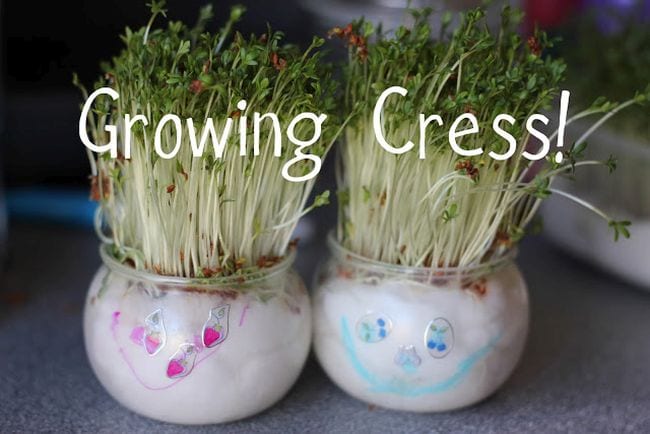
Watercress is fun to watch because it grows very quickly on damp cotton. Try growing it as “hair,” or sow the seeds to create patterns or letters.
Learn more: Watercress Growing at The Imagination Tree
11. Sprout sweet potatoes
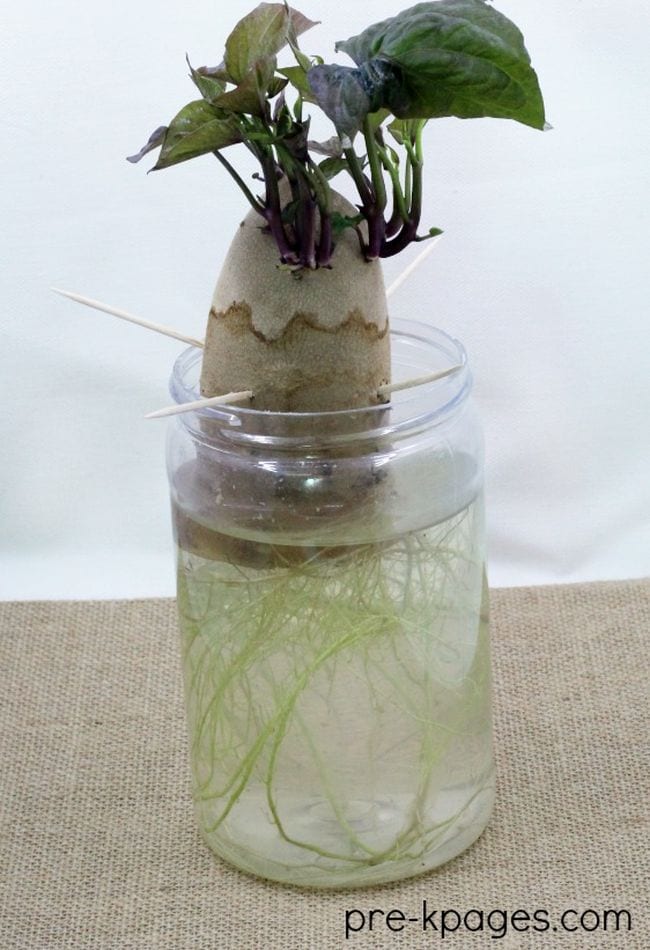
Not every plant needs seeds to reproduce! Grow a sweet potato to learn about a different kind of plant life cycle.
Learn more: Sprouting Sweet Potatoes at Pre-K Pages
12. Discover why seeds have coats
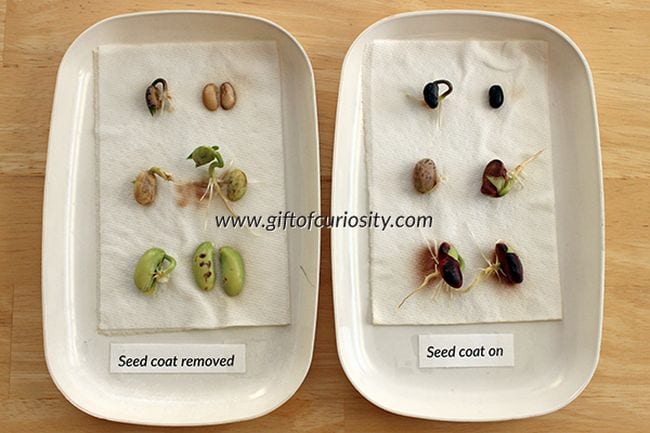
Seed coats provide protection, but what happens if you remove them? Go hands-on and find out in this interesting experiment.
Learn more: Seed Coating Experiment at Gift of Curiosity
13. Sculpt the plant life cycle in clay
Can’t grow a plant yourself? Sculpt one from clay instead! Watch this Claymation video for inspiration, then pull out the Play-Doh and get to work!
14. Don’t forget about pollinators!
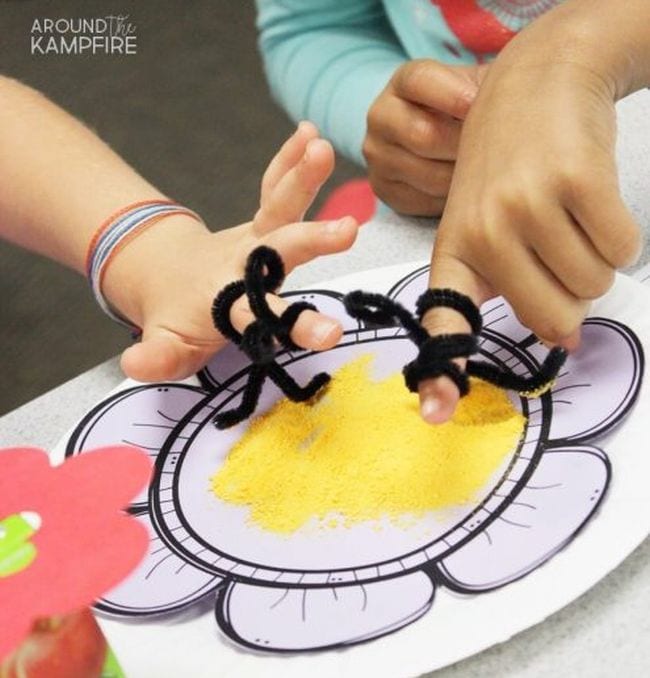
Seed-bearing plants require pollination, often helped along by insects like bees and butterflies. This pipe cleaner activity shows little ones how pollination works.
Learn more: Pipe Cleaner Pollinators at Around the Kampfire
15. Grow an avocado
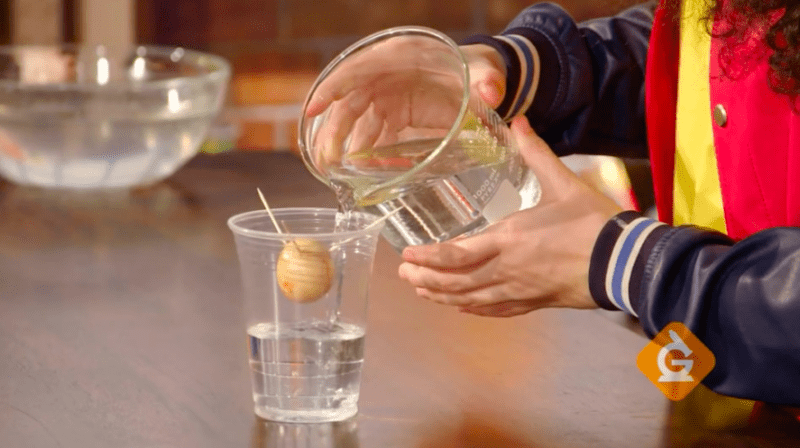
Did you know that an avocado seed has a fault line? Learn this and more in this DIY activity that teaches kids how to grow their own avocado plant.
Learn more: Grow an Avocado at Generation Genius
16. Explode a seed pod
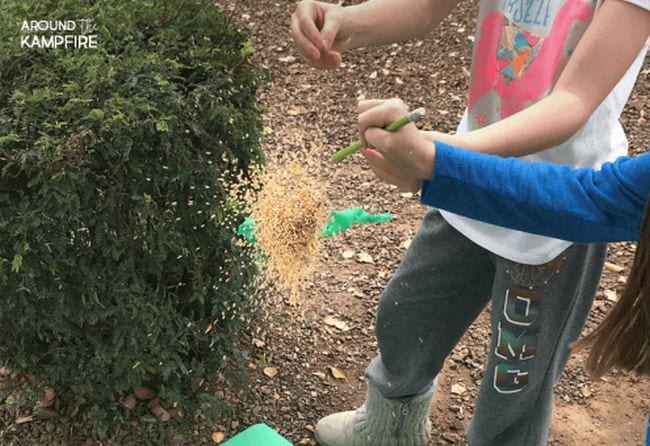
Plants that rely on seeds as part of their life cycle need to ensure they spread far and wide. Some plants even have exploding seed pods that help the process along! Learn about them in this cool activity.
Learn more: Seed Pods Activity at Around the Kampfire
17. Display a life cycle bulletin board
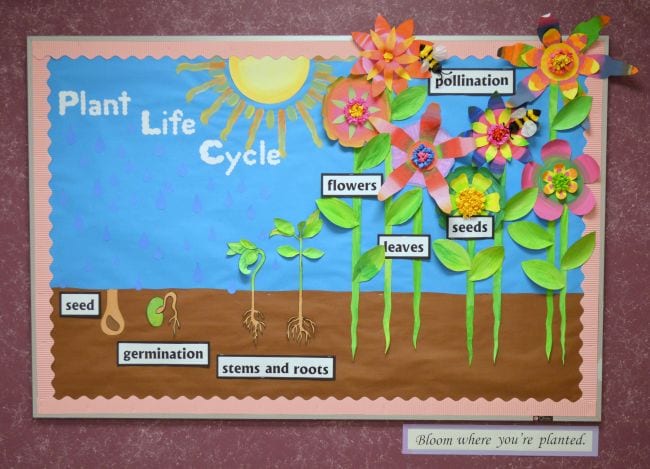
We love how clean and easy to understand this plant life cycle bulletin board is. And those colorful flowers are a fantastic touch!
Source: Life Cycle Bulletin Board at Leslie Anderson on Pinterest
18. Go outside to conduct a plant study
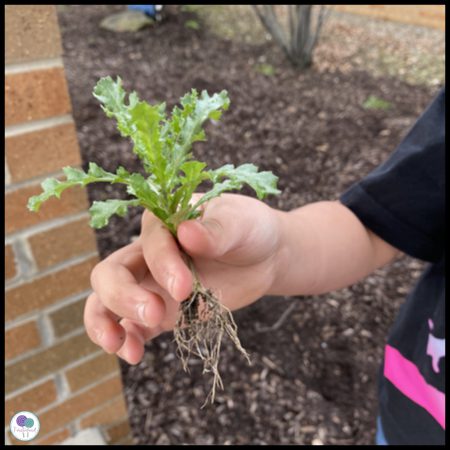
After reading a story about what botanists do, students head outside to do a little field work themselves. Not only will they learn a lot, they may help clean up the school grounds!
Learn more: Going on a Plant Field Study at Firstieland
19. Create a plant life cycle hat
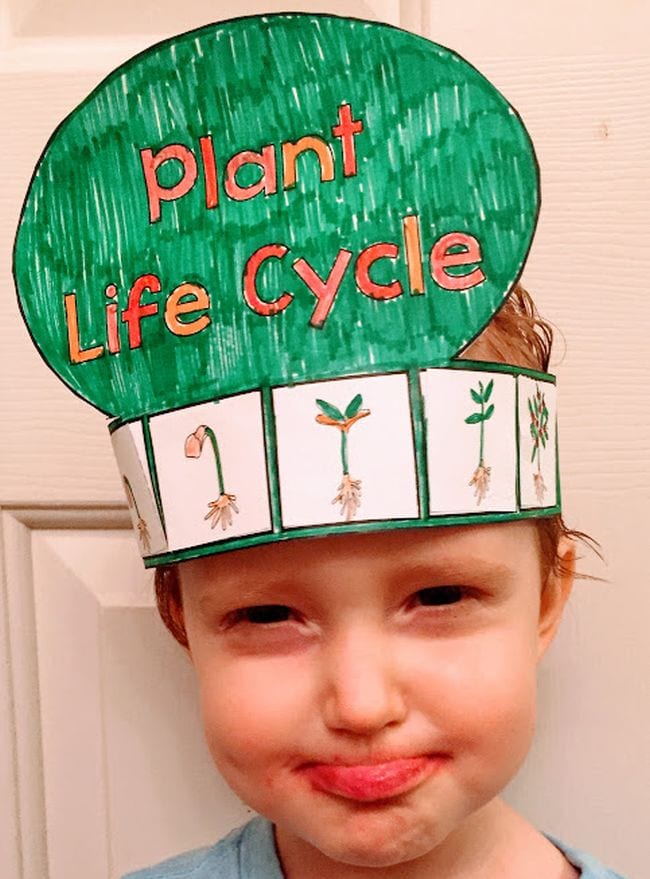
Get some practice sequencing as you cut out and paste together this sweet little topper. Kids will love wearing it as they learn.
Learn more: Plant Life Cycle Hats at Herding Kats in Kindergarten
20. Learn how seeds spread
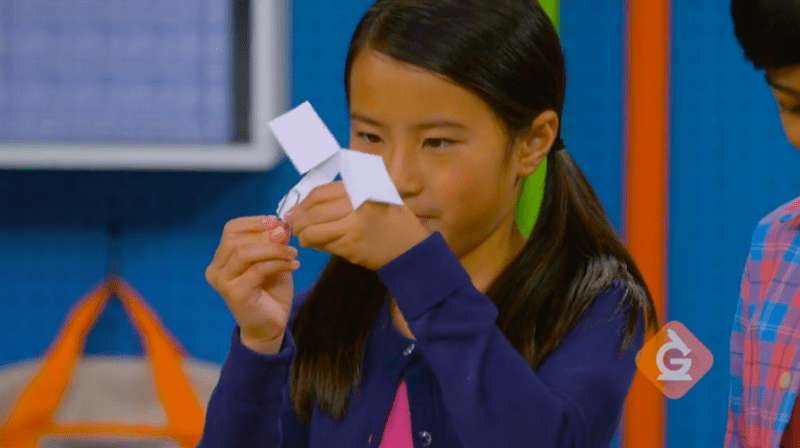
Using a piece of paper and a paper clip, students will make a model of a maple seed. After they launch their seeds, they can watch them spin to the ground like helicopters.
Learn more: Make a Seed Model at Generation Genius
21. Fold a flower flip-book
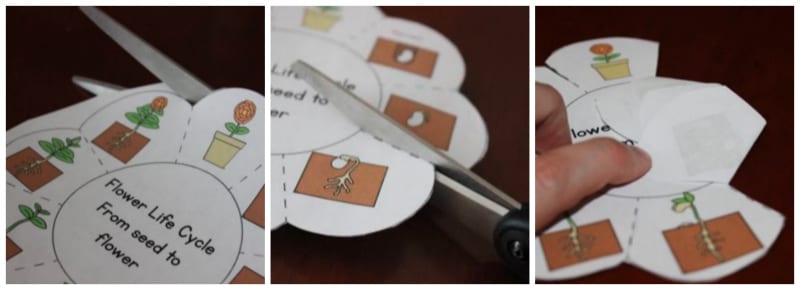
The petals of this free printable flower unfold to reveal the stages of a plant’s life cycle. So clever!
Learn more: Flower Flip-Book at Teaching Momster
22. Diagram paper plants with shredded soil
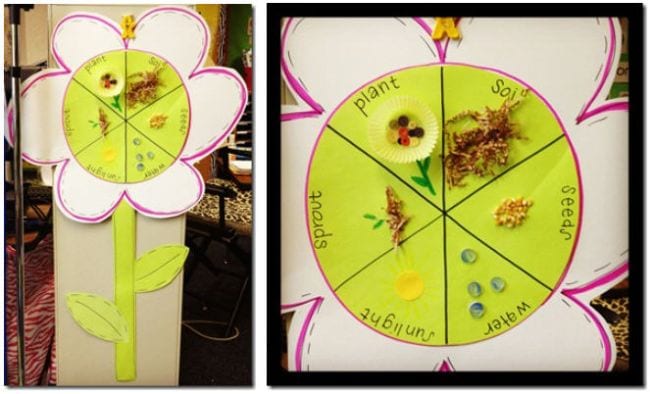
This plant life cycle diagram uses paper shreds for soil, a cupcake liner for the flower, and more smart little details that kids will really appreciate.
Learn more: Diagram Paper Plants at Cara Carroll
23. Leaf chromatography
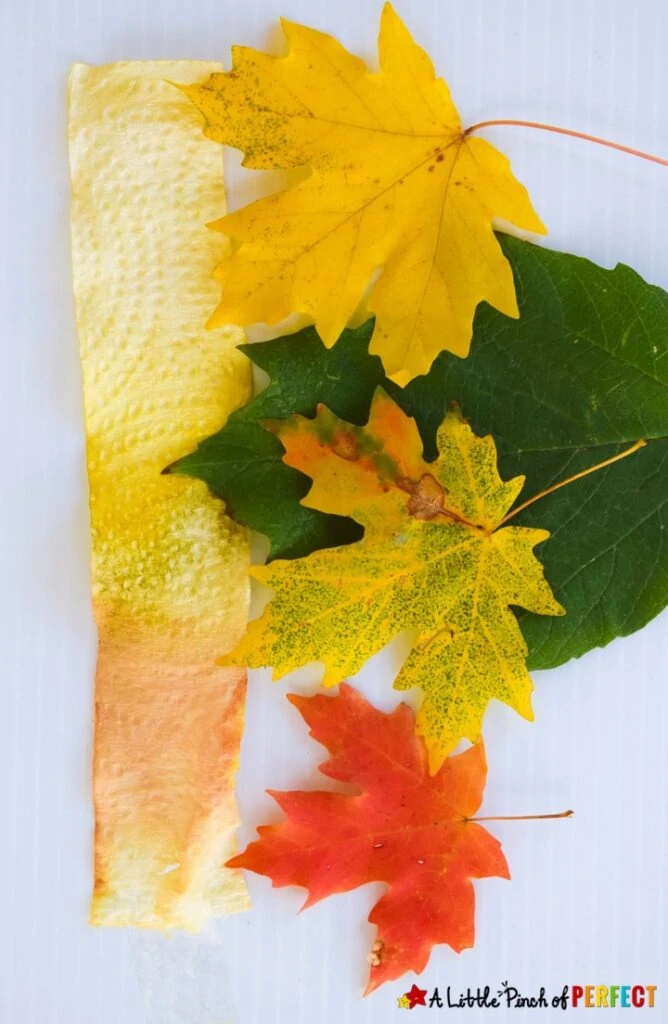
The different colors found in leaves are created by different chemicals—chlorophyll, flavonoids, carotenoids, and anthocyanins. In this experiment, students will see if they can get the pigments in the leaves to separate through chromatography so they can take a closer look at the colors found inside leaves.
Learn more: Leaf Chromatography at A Little Pinch of Perfect
24. Paint with chlorophyll

Integrate art into your plant life cycle activities! In this activity, students learn the importance of chlorophyll and its role in how a plant makes its own food.
Learn more: Paint With Chlorophyll at Around the Kampfire
25. Try a digital flip-book
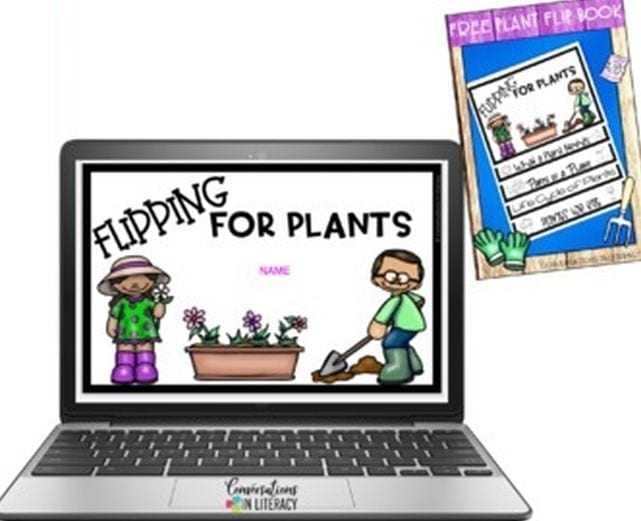
Learning online? This free digital activity includes a printable version for kids to complete at home, but it can also be completed virtually to save paper.
Learn more: Digital Flip-Books at Conversations in Literacy
26. Compare soils
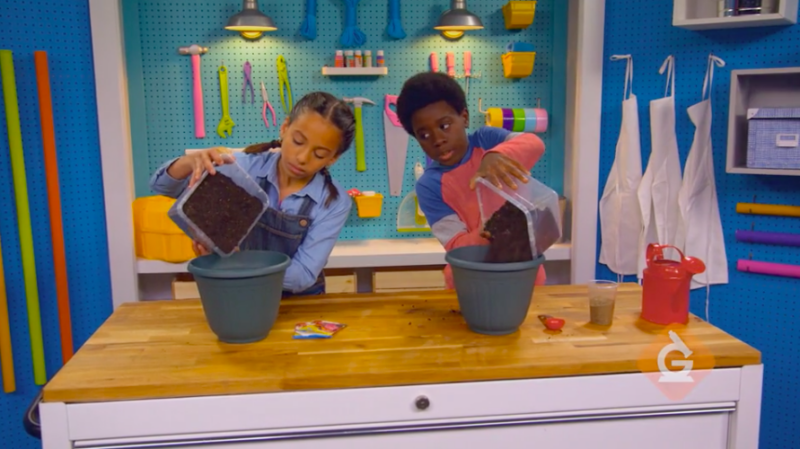
Plants need many things to grow, including sunlight, water, and food. In this experiment, students will see which plant grows better, one in plain soil or one in fertilized soil.
Learn more: Plant Growth Conditions at Generation Genius
27. Regrow kitchen scraps
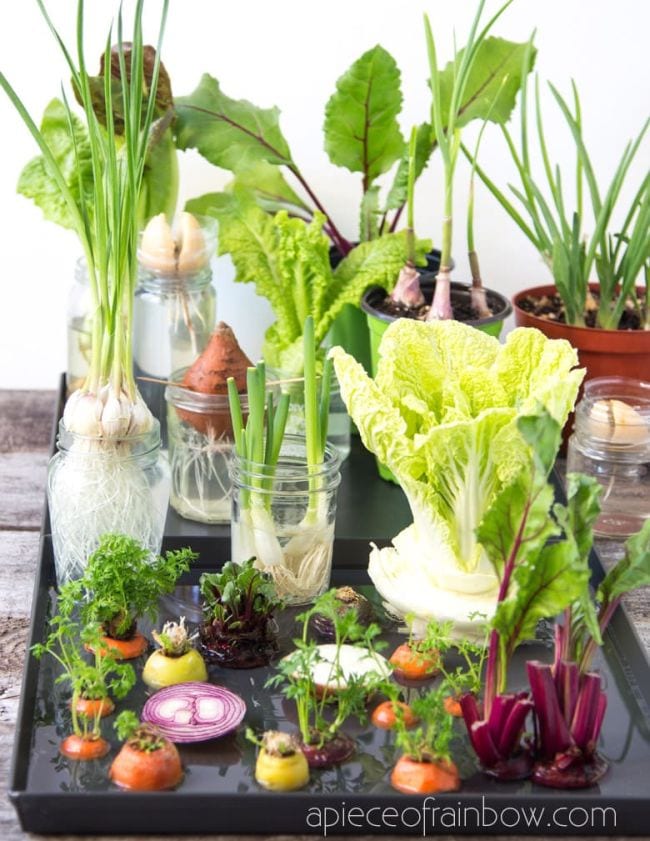
Here’s another project showing that not every plant needs seeds. Save kitchen scraps and try regrowing them, with or without soil.
Learn more: Regrow Kitchen Scraps at A Piece of Rainbow
28. Plant seeds in ice cream cones
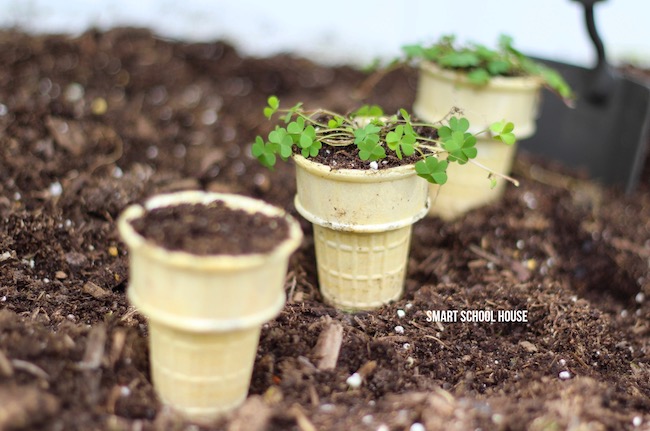
Learn how to use 100% biodegradable ice cream cones as planters for seedlings. There’s a trick to making it work!
Learn more: Ice Cream Cone Seedling Garden at Smart School House
29. Make a sunny sunflower
Make 3D sunflowers with fold-out leaves that teach the life cycle of the sunflower. Then, try growing your own !
30. Do a plant-life-cycle book study
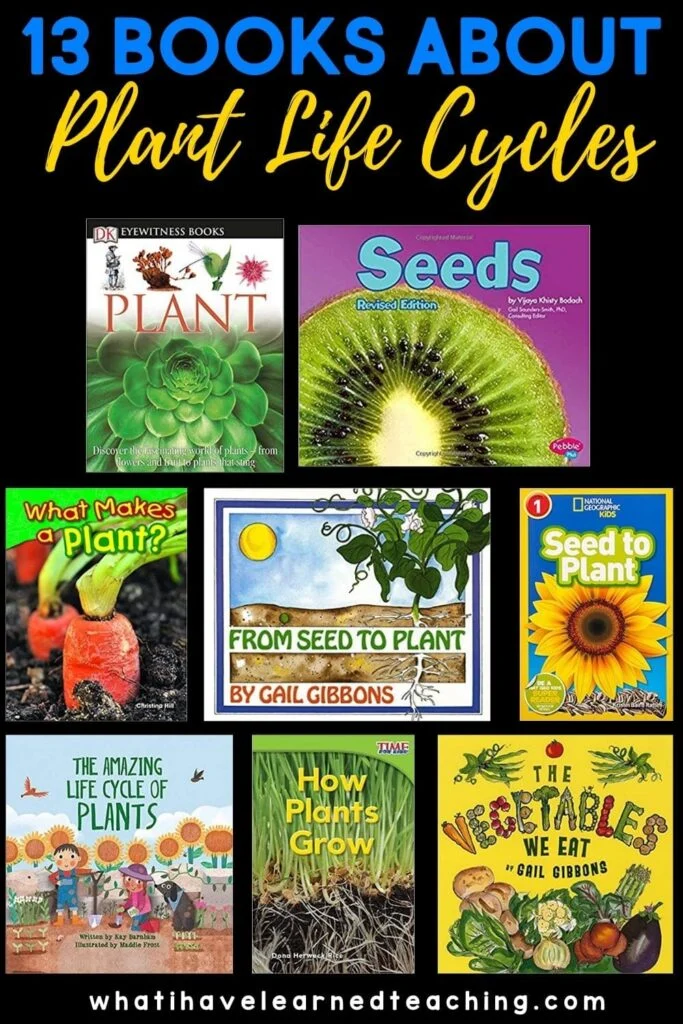
Break your students into small groups and have each group read one of these stories, then share what they learned with the class. From how plants grow and where our food comes from to the amazing power of seeds, your students will eat up these interesting stories.
Learn more: Plant Life Cycle Books at What I Have Learned
31. Learn what germination means
This easy-to-follow and fun-to-watch video teaches kids all about germination—the process of the growth of a seed into a plant.
32. Keep a plant journal
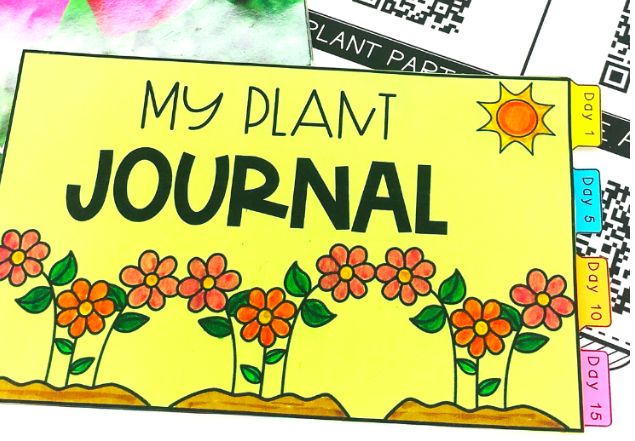
What better way to learn about the plant life cycle than with careful observation? Every few days after you plant your seeds, students will draw and label the changes that they see in their growing plant.
Learn more: Plant Journal at Chalkboard Chatterbox
33. Learn the “Parts of a Plant Song”
Roots, stem, leaves, and flowers! This catchy tune will help your young learners understand the parts of a plant in a memorable way.
If you liked these plant life cycle activities, check out Clever Ways To Bring Gardening Into the Classroom .
Plus, get all the latest teaching tips and ideas when you sign up for our free newsletters .
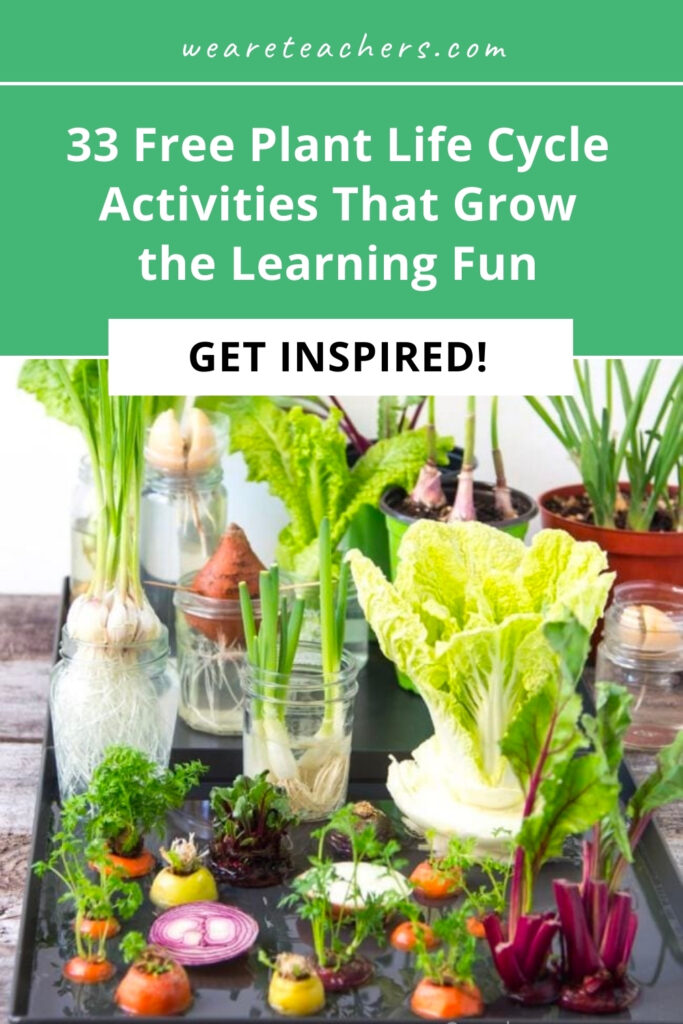
You Might Also Like
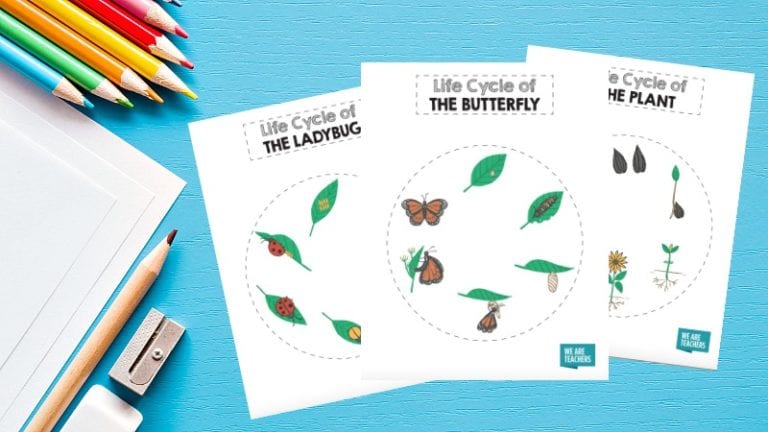
These Free Life Cycle Printables Are Perfect for Spring Science Lessons
Kids will love this interactive way of learning about the life cycle of plants and animals. Continue Reading
Copyright © 2024. All rights reserved. 5335 Gate Parkway, Jacksonville, FL 32256
- Create new account
- Reset your password
Register and get FREE resources and activities
Ready to unlock all our resources?
Plants and growth
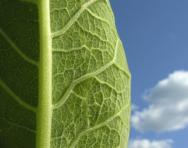
What are plants?
Plants are living things that grow from the soil and turn light from the Sun into food. Plants can be big or small, from giant trees to tiny patches of moss.
Plants use a process called photosynthesis to turn sunlight into food in their leaves. They can then use this food to grow. To help them do this, they also need water and nutrients that they take from the soil with their roots, and carbon dioxide that they absorb from the air.
Top 10 facts
- Plants turn light from the Sun into food that they need to grow.
- Plants also need water and nutrients from the soil , and carbon dioxide from the air .
- Animals can eat plants so that they can use the food the plants created to grow too. Animals can’t turn energy from the sun into food so they have to get it by eating plants or by eating other animals.
- The biggest type of plant on earth is a tree called the giant redwood. Some of these trees are as tall as a 15-storey building, and up to 3,500 years old.
- Most plants reproduce by creating seeds using pollen from other plants of the same type.
- Plants use flowers to attract insects to carry pollen from one plant to the next.
- Flowers contain a sugary liquid called ‘nectar’ that the insects eat and while they are in the flower, they get pollen on them that they carry to the next flower they go to.
- Some plants spread their seeds by letting them float on the wind, other plants encourage animals to eat them and some plants just drop them on the ground.
- Not all plants get all their energy from sunlight. The Venus flytrap and pitcher plants trap and eat insects!
- Some people are allergic to pollen. All the pollen in the air in the spring makes them sneeze. This is called ‘hayfever’.
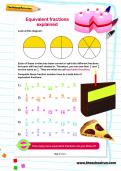
Boost Your Child's Learning Today!
- Get a tailored learning plan for your child
- Complete the activities added each week
- Watch your child's maths & English confidence grow!

Did you know?
- Plants need light to grow. If you put one plant on a windowsill in the sunlight, and one plant in a dark cupboard, the plant in the sunlight will be green and healthy and the plant in the cupboard will start to die.
- Brightly coloured flowers look very pretty to us, but that’s not why plants grow them. The bright colours and patterns on the flower petals are very attractive to insects . The insects come to the flowers to drink nectar, and they carry pollen from one plant to the next.
- When a plant has been pollinated, it creates a seed (or lots of seeds). These seeds will make the next generation of plants. A seed contains the start of a new plant and some food to help it grow until it’s big enough to get food on its own.
- When a seed sprouts and starts to grow, it is called ‘germination’. You can see germination in action by taking some seeds and putting them on a damp piece of kitchen towel in a dark cupboard. This makes the seed think it’s in some moist soil, and it will start to grow after a few days.
- Lots of types of animal only eat plants. They are called ‘herbivores’.
- The huge variety of fruit and vegetables that you find in the supermarket doesn’t just turn up there by chance. They have to be carefully grown and looked after. People who grow plants for people to eat are called farmers.
Can you spot all these images in the gallery?
- A man sitting at the base of a giant redwood tree (this is the third largest redwood tree in the world) (Credit: Mdvaden via Wikimedia)
- A honey bee extracting nectar
- A hummingbird drinking nectar from a flower
- Looking up at a giant redwood tree
- Lots of different kinds of fruits. All of these contain seeds
- Lavender growing in a field
- A sundew swamp plant

Plants often go to a lot of trouble to attract animals that will help them pollinate their flowers or spread their seeds. Some flowers are shaped so that only certain kinds of insects or birds are able to get into the flower to collect the nectar.
Sunflowers grow into tall flowers very quickly. If you plant sunflowers in different places in the garden – some in shady corners, some in sunny spots – you can see which ones grow the fastest by measuring them every day.
Animals eat plants to get the food that they need to grow because only plants can convert energy from the Sun into food. Even animals like lions and tigers that only eat meat rely on plants for their food because the animals that the lions and tigers eat get their food from plants. This is called the food chain .
Insects aren’t the only type of creatures that plants use to help with pollination. Some small birds like the hummingbird or small bats are involved in the pollination process too.
When a flower has been pollinated, seeds will develop in the ovaries at the bottom of the flower. These seeds will grow into plants of the same species and the plant will use animals, wind or an explosive seed pod to spread them around.
Some seeds are very light, like the seeds from a dandelion, and plants use the wind to carry these long distances. Other seeds grow in pods like peas – when these pods dry out, the pod will burst and fire the seeds away from the plant.
Many plants use animals to spread their seeds , and they can do this in different ways. Some seeds have hooks on them so that they catch on fur or skin, and the animal carries them a long way before the seed falls off. Some seeds develop into fruits – this is when the flesh of the ovary that the seed is in grows into something that animals like to eat (like tomatoes, cherries or apples) – the animals eat the fruit and then either spit out the seeds or they come out in their poo.
Carnivorous plants are plants that also eat meat. They use sticky pads or slippery tubes to trap animals (mostly insects) inside them and then they dissolve them and eat them. Venus flytraps and pitcher plants are examples of these.
Some plants live for a very short amount of time before they flower and spread their seeds. Many types of plant that we like to eat (like tomatoes or cucumbers) only live for one year and die in the winter. Other plants can live for several years and some plants like trees can live for hundreds, or even thousands of years!
Words to know:
Bulb – a form some plants take when they are dormant; some plants like daffodils or onions survive the winter as a bulb under the soil, and grow new stalks and leaves in the spring Carpel – the female reproductive parts of a flower; it receives pollen from other plants and protects seeds while they develop Deciduous – deciduous trees are ones that shed their leaves in winter; leaves on these trees are normally wide and flat Evergreen – evergreen trees (also called conifers) are ones that keep their leaves all year around; they often have leaves shaped like needles Flower – a flower contains the reproductive parts of a plant; they are often brightly coloured to attract insects Fruit – flesh surrounding a seed or seeds that makes it attractive for animals to eat them Germination – the process of a seed starting to grow to create a new plant Leaves – plants have these on their branches or stem, and normally use them to make food from sunlight; this is called photosynthesis. Ovary – a chamber at the base of the carpel; this contains ovules that are fertilised by pollen to create seeds Nectar – a sugary liquid that is found in many flowers; nectar attracts insects to drink it and encourages them to travel from flower to flower spreading pollen Petal – special leaves that are part of a flower. They are often brightly coloured to attract insects Photosynthesis – the process plants use to make food from sunlight; it also needs carbon dioxide from the air, and water from the soil Pollen – pollen is needed to create seeds to grow new plants; sometimes pollen is carried on the wind, and sometimes it is carried from plant to plant by insects Seed – seeds are created using pollen from other plants; they are a new plant and normally need some food to help it start to grow Stalk/stem – the central part of the plant that all the leaves and branches connect to; in trees, this is called the trunk Stamen – the male reproductive parts of the flower; they are covered in pollen that either rubs off on passing insects or is blown away by the wind Stigma – this is at the top of the carpel; its job is to catch pollen that is floating on the wind or is on the back of an insect that has come to the flower Style – a tube in the centre of the carpel to take pollen to the ovary Tree – large plants that live a long time, have a very tough, woody stem called a trunk, and normally have lots and lots of leaves and a large number of branches Tuber – part of the stem or root used to store food by the plant; potatoes and carrots are tubers Vegetable – bits of plant we eat that aren’t fruits; most vegetables are the root, stem or leaves of the plant
Related Videos
Just for fun...
- Learn about plants and play games
- Take a walk through a virtual forest
- Plant specimens in the best possible environment for them
- Find out where the plant ingredients for some of your favourite foods came from
- Investigate the mysteries of seeds and soil with Detective Le Plant
- Take a virtual trip to the UK's most famous garden, the Blue Peter Garden
- Learn to identify autumn leaves
- Complete an online quiz about seed dispersal
Best children's books about plants and growth
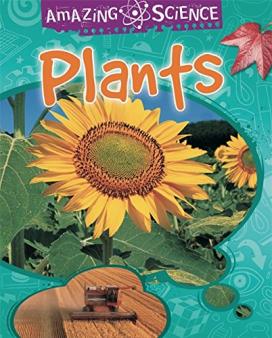
Find out more:
- A kids' guide to plants from DKfindout!
- Read about plant life cycles and find out what a plant needs to grow
- Look at an interactive guide to Scottish woodlands (Select non-flash)
- Learn about the biology of plants
- Use an interactive simulation to learn how tree ring patterns tell us about past climate conditions
- Information about backyard plants
- Discover how plants deal with dry days
- Find out more about photosynthesis
- Why leaves change colour in the autumn
- Watch videos for kids about the parts of a plant , what plants need to grow and why plants need water and light
- Watch BBC animation clips about plants
- Revise the the life cycle of plants from seed to dispersal with a BBC Bitesize animation
- Find out more about plant adaptations
- Information about how a seed grows into a plant
See for yourself
- Visit Kew Gardens in London to find out more about plants and see unusual species
- See how the Eden Project has transformed an old China Clay quarry into a habitat for plants
- Visit the Botanical Gardens in Bristol
- Visit the Botanical Gardens in Oxford
- Visit the Botanical Gardens in Durham
- Visit the Botanical Gardens in Birmingham
- Visit the Botanical Gardens in Cambridge
- Visit the National Botanic Garden of Wales near Carmarthen
- Visit the Royal Botanic Garden in Edinburgh
- Visit the Botanic Gardens in Belfast

Give your child a headstart
- FREE articles & expert information
- FREE resources & activities
- FREE homework help
Biology for Kids
- Most plants make their own food through a process called photosynthesis.
- Plants have a cuticle, meaning they have a waxy layer on their surface that protects them and keeps them from drying out.
- They have eukaryotic cells with rigid cell walls.
- They reproduce with spores or with sex cells.

- Vascular - These plants have specific tissues that help to move materials such as water through the plant. They are further divided into non-flowering plants and flowering plants. Most of the organisms you probably think of as plants, such as trees, bushes, and flowers, fit into this group.
- Nonvascular - These are smaller plants, such as mosses, that use diffusion and osmosis to move material through the plant.
- The fastest growing woody plant in the world is bamboo. Bamboo can grow up to 35 inches in just one day!
- Tomatoes and avocados are considered fruits.
- Fungi (mushrooms) and algae (seaweed) are not considered plants, but are part of their own kingdoms.
- There are nearly 600 different species of carnivorous plants that actually eat insects and small animals.
- The largest flower in the world is the rafflesia which can grow to over three feet in diameter.
- Take a ten question quiz about this page.
- Plant Biology Word Search
- Plant Biology Crossword Puzzle
- Listen to a recorded reading of this page:

Reading & Math for K-5
- Kindergarten
- Learning numbers
- Comparing numbers
- Place Value
- Roman numerals
- Subtraction
- Multiplication
- Order of operations
- Drills & practice
- Measurement
- Factoring & prime factors
- Proportions
- Shape & geometry
- Data & graphing
- Word problems
- Children's stories
- Leveled Stories
- Context clues
- Cause & effect
- Compare & contrast
- Fact vs. fiction
- Fact vs. opinion
- Main idea & details
- Story elements
- Conclusions & inferences
- Sounds & phonics
- Words & vocabulary
- Reading comprehension
- Early writing
- Numbers & counting
- Simple math
- Social skills
- Other activities
- Dolch sight words
- Fry sight words
- Multiple meaning words
- Prefixes & suffixes
- Vocabulary cards
- Other parts of speech
- Punctuation
- Capitalization
- Narrative writing
- Opinion writing
- Informative writing
- Cursive alphabet
- Cursive letters
- Cursive letter joins
- Cursive words
- Cursive sentences
- Cursive passages
- Grammar & Writing
Breadcrumbs
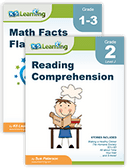
Download & Print From Only $1.79
Grade 2 Plants Worksheets
The life cycle of plants.
These grade 2 science worksheets on plant life focus on what plants need to grow, how they develop and, especially, the mechanisms by which they pollinate and disperse seeds .

Sample Grade 2 Plants Worksheet
What is K5?
K5 Learning offers free worksheets , flashcards and inexpensive workbooks for kids in kindergarten to grade 5. Become a member to access additional content and skip ads.

Our members helped us give away millions of worksheets last year.
We provide free educational materials to parents and teachers in over 100 countries. If you can, please consider purchasing a membership ($24/year) to support our efforts.
Members skip ads and access exclusive features.
Learn about member benefits
This content is available to members only.
Join K5 to save time, skip ads and access more content. Learn More
- Forgot Password?
Plants (Botany) Resources
From food and shelter to medicine and clothing, plants play a crucial role in our lives. Incorporate botany in your classroom with these lessons and printables on trees, flowers, ferns, molds, and mosses. There are science activities on plant cells, photosynthesis, pollination, and much more! From gardening to chromatography, you'll find fun ideas for Earth Day and Arbor Day. Incorporate the study of flora across your curriculum with art, math, and English resources for all ages.
Whiteboard Compatible Mini-Lessons
- The Amazing Rain Forest Mini-Lesson
- Introducing Deserts Mini-Lesson
- More Mini-Lessons
Bulletin Board Ideas
- Tree Pattern
- Rainbow of Flowers Bulletin Board
- Tree Bulletin Board Example
- Evergreen Tree Bulletin Board for Winter
Printables for Grades K-1
- Plant Parts (Grades 1 & 2)
- Plants & Trees Printable Book (Grades K-4)
- How a Seed Grows -- Little Book
- From Seed to Plant
- What's Wrong With This Picture?
- Fruit Patterns
- More Plant Printables
Printables for Grades 2-5
Careers: Who Am I?
Layers of the Rain Forest Worksheets
All About Fossils
Go, Seeds, Go!
- Classification Puzzle
- What Is Inside a Seed?
Dominant and Recessive Genes
Printables for Grades 6-8
- Animal Cell/Plant Cell (Blank) Printable
What Are the Parts of a Seed?
- The Parts of a Plant Cell and an Animal Cell
Life Science Test: Plant Structure and Function
Printables for Grades 9-12
- What Are Viruses & Bacteria?
- Which Soil Is Best for Plants?
- Comparing Monocots and Dicots
- What Are Tropisms?
- The Parts of a Flower
Activity: Seed Dispersal
- What Are Seeds and Fruits?
Lesson Plans
In Which Liquids Do Seeds Grow Best?
Layers of the Rain Forest
- Which Foods Do Molds Love Best?
- Plants of the Rain Forest
- Class Garden
- The Sunflower
- Sunflowers, Van Gogh, and You
- More Plant Lesson Plans
Graphic Organizers
- Ways to Help the Environment
In a Garden
- KWL Chart - Plants
- The Growth of a Radish Seed
- Seeds Grow into Plants
- What Is in Soil?
- A Seed Chart
- More Plant Graphic Organizers
Earth Day Activities
- Plants of the Rain Forest Rubric
- There's an Owl in the Shower
- Box Up Your Habitat
- Photosynthesis
- Classifying Cerealites
- "My Garden Song"
- More Earth Day Teacher Resources
Arbor Day Activities
- Arbor Day Book
- Autumn Tree
- A Tree is Nice Book -- Little Book
- Tolkien's Middle-earth Unit 6: Treebeard's Lament
- Winter Trees Tree Identification Handout
- More Arbor Day Activities
Plant Resources for Art Class
- Plant Pollination
- Life Cycle Charts
- Sorting Seeds
- Make a Dried Bouquet
- Darling Daffodil
- Science Fun: An Apple a Day
- More Plant Resources for Art Class
Digital Books
- Ready, Set Grow!
- Eye Wonder: Plant
- Eyewitness: Plant
- Eye Wonder: Forest
- E.Guides: Plant
- Gallery of DK Digital Books for Earth Science
Literature & Plants Connected
- Literature & Math: Stories About Flowers
- The Mountain That Loved a Bird
- Literature & Math: If You Give a Moose a Muffin & What If?
- Poke & Look Learning Books
- NSTA Recommends -- Interdisciplinary Connections for Grades 9-12
- Reading Warm-Up 81 for Gr. 1 & 2: Fairy Tales and Folklore
- More Literature Resources on Plants
Plant Resources for Reading & Language Arts
- Arbor Day Wordsearch
- Flower Power Crossword Puzzle
- Eyewitness Plant Printables
Nonfiction Reading Warm-Up: Colonial Gardens
- Desert Ecology Reading Warm-Up
- Science Key Term Review: Plant Structure and Function
- More Popular Plant Resources for Reading & Language Arts
Plant Resources for Math Class
- Investigate Activity: Estimating and Measuring Mass
- Math Fun with Plants
- Family Activities: Plant a Garden
- What Do the Roots and Stems Do?
- Addition Practice and Connect the Dots
- Spider Plants
- More Plant Resources for Math Class
Science Activities on Plants
- How Does Your Garden Grow?
- Traveling Seeds
- How Do People Use Plants?
- Soda Bottle Terrarium
- More Science Activities on Plants
Plant Resources for Earth Science Class
- Herbs in the Classroom
- Autumn Veggies and Fruits
- Traveling Seeds Worksheet
- More Plant Resources for Earth Science Class
Plant Physiology Resources
- Social Studies: The Maya
- Science: How to Plant Corn
- Science: How Does Popcorn Pop?
- Science: Build a Maize Maze
- Cell Processes and Energy: Just Count the Bubbles
- Gallery of DK Digital Books for Life Science
- Plant Cells
- More Plant Physiology Resources
Flower Resources
- Explore Activity: A Sunflower Seed Grows
- Flower Pollination
- How Do Flowering Plants Reproduce?
- The Growing Flower
- What Are Flowers?
- More Flower Resources
Rain Forest Resources
- Rain Forest Products Lesson
- Science Reading Warm-Up: Rainforest Ecology
- More Rain Forests: Teacher Resources
Plant Resources for Social Studies Class
- Women Nobel & Pulitzer Prize Winners
- The Popcorn Plant
- George Washington Carver
- Science and Social Studies: House Plants
- Science and Technology: Planting Trees
- More Plant Resources for Social Studies Class
Plants & History Connected
- Rev Up Your Veggies: A Physical Science Activity
- How Peanuts Grow
- More Plant Resources for History Class
Related Resources
- Gardening Resources
- Earth Day Teacher Resources
Recommended Plants Resources
CHOICE BOARDS
Spring Plants Choice Board for Elementary Grades
LESSON PLANS
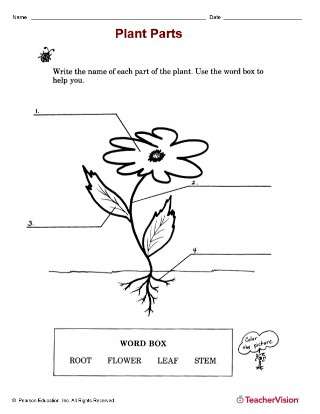
Plant Parts (Grades 1 & 2)
What Is Photosynthesis?
Life Science Diagnostic Test
Life Science Test: Interactions Among Living Things
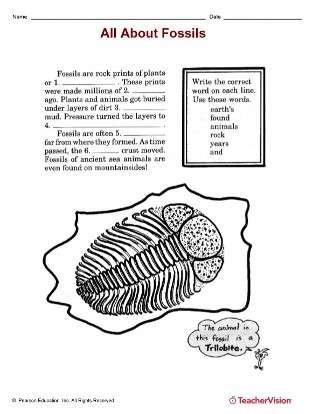
Can Cloning Make a Better Plant?
Food From Plants and Animals

What's Wrong with This Picture?
TEACHING RESOURCE
Instant Expert
Do Plants Sweat Like People Do?
Cranberry Facts
DAILY WARM-UPS
Life Science Test: Characteristics of Living Things
GRAPHIC ORGANIZERS


STEM Plant Activities- 10 Ways to Learn About Plants!
Categories STEM Activities
Teaching science and STEM this spring? If you’re checking out spring STEM activities , learn about plants with these STEM plant activities that are all about plants, biology, and plant life cycles!
There are so many things that kids will want to learn about plants, and these hands-on STEM activities keep it from being boring! Even the most science-hating kid will have a blast with these activities.
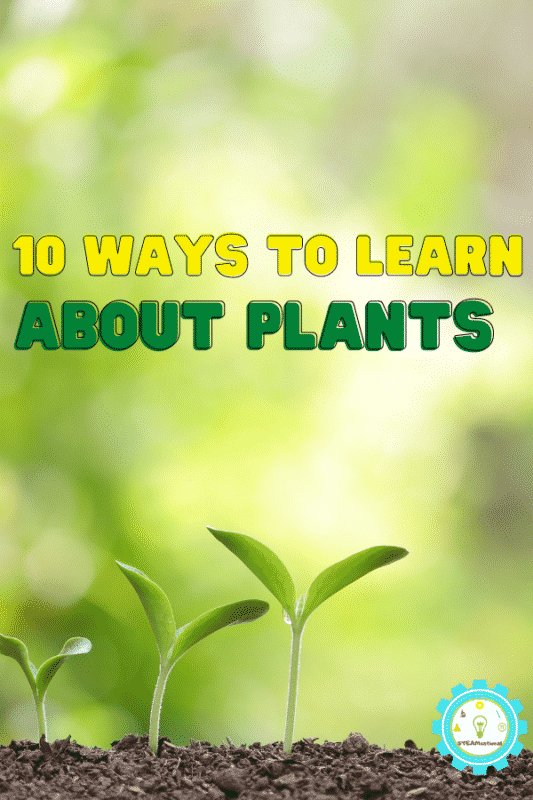
Plant Activities with a STEM Focus
STEM plant activities, lesson plans, and worksheets. Teach students all about plant biology and life cycles with these hands-on plant lessons! Find our favorite plant science activities at the end of this article!
What is a STEM Plant Activity?
A plant activity teaches kids something about how plants work. The activities might teach kids about life cycles, seed germination, the parts of a plant, how plants reproduce, how plants get nutrients, how plants make oxygen, photosynthesis, and a whole lot more!
There is so much to learn about plants and when you use a STEM lens, you can learn so much about the world and how to improve the world for plants and with plants!
What You Need for STEM Plant Activities
If you do any of the plant science activities on this list, you’ll want to check out these Amazon affiliate links for products that we love using with our STEM activities!
Don’t forget to pick up a set of our spring STEM challenge cards to use in your STEM centers this spring. Here’s how to set up a STEM center.
If you want activities for specific ages, check out our spring STEM activities for preschool, spring lesson plans for elementary students, and spring STEM activities for middle school.
Spring STEM Lesson Plans
If you want ready-to-go, low-prep spring lesson plans, you’ll love these resources.
- March STEM Lesson Bundle
- April STEM Lesson Bundle
- May STEM Lesson Bundle
- Spring Science Experiments
- Spring STEM Challenge Cards with Instructions
Our Favorite STEM Plant Activities
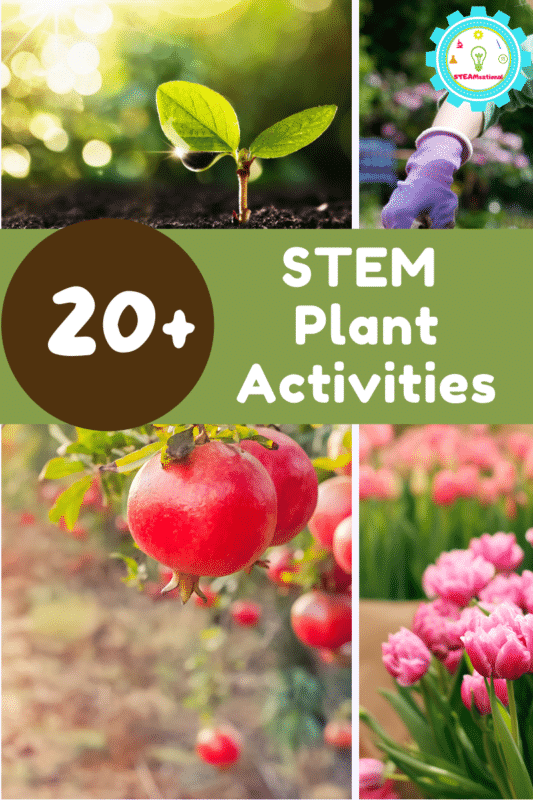
It’s spring, so that means it’s a great time to learn about plants! These STEM activities all have fun plant-related themes that make learning about plants fun.
You can learn about capillary action with this Color Changing Flowers Experiment .
Take a flower apart and learn about the parts of a flower in the Parts of a Flower Dissection activity.
Learn about how plants work and basic plant biology when you learn How to Make a 3D Model of the Parts of a Plant .
Learn about native plants around the world in this Learning about Flowers around the world activity.
Get the Apple Tree Life Cycle Worksheet and learn about an apple’s life cycle.
Explore photosynthesis and learn How Trees Make Oxygen.
In this Seed Germination Experiment kids will experiment with finding the right kind of soil to grow different types of seeds.
The Egg Shell Garden Science Project is a fun alternative garden for small spaces.
This activity about plant needs teaches kids about what plants need to survive.
More Spring STEM for Kids
20 Engaging and Fun Spring STEM Challenges for Kids
Spring Lesson Plans for Elementary with a STEAM Focus
The Ultimate List of Spring Science Experiments for the Classroom
Plant biology activities
Share this project with a friend!
Monday 11th of December 2023
you do not help me at all you need to get a live

©Copyright Mandy Barrow 2013 primaryhomeworkhelp.com
Follow me on Twitter @mbarrow
I teach computers at The Granville School and St. John's Primary School in Sevenoaks Kent.
Part of KS1 Science
The lifecycle of a plant
Learn about the lifecycle of a plant.
What does a plant need to grow?
Learn what the four important things are that plants need to grow and survive.
Play Galaxy Pugs science game!
The Regenerators Green Lessons
All Bitesize Primary games
BBC Teach: KS1 Science
Science Activities
Game - Total Darkness
- External link External link
Night Zookeeper
- Subscription Subscription
- Reading Comprehension Worksheets
- Inferences Worksheets
- Context Clues Worksheets
- Theme Worksheets
- Main Idea Worksheets
- Reading Games
- Summary Worksheets
- Online Tests
- Figurative Language Worksheets
- Short Stories with Questions
- Nonfiction Passages
- Genre Worksheets
BECOME A MEMBER!
Carnivorous plants.
Plants are known for sitting still, but some plants are devious killers. Learn more about the amazing world of carnivorous plants with this short text. Then answer CCSS aligned multiple-choice and extended-response questions. Suggested reading level for this text: Grade 4-8

Readability Score for Carnivorous Plants
Nonfiction comprehension common core state standards.
- Author's Purpose Worksheets
- Characterization Worksheets
- Conflict Worksheets
- Fact and Opinion Worksheets
- Figurative Language Activities
- Figurative Language Poems with Questions
- Genre Activities
- Irony Worksheets
- Making Predictions
- Mood Worksheets
- Nonfiction Passages and Functional Texts
- Parts of Speech Worksheets
- Poetic Devices
- Point of View Worksheets
- School Project Ideas
- Setting Worksheets
- Simile and Metaphor Worksheets
- Story Structure Worksheets
- Text Structure Worksheets
- Tone Worksheets
- ALL PAGES AND WORKSHEETS

IMAGES
VIDEO
COMMENTS
Hundreds of thousands of different species, or kinds, of plant grow on Earth. Some plants are so tiny that people can hardly see them. Others are trees that grow as tall as skyscrapers.
There are four basic stages of a plant lifecycle which are described as follows: 1. Seed - The first stage of the plant lifecycle is when the seed gets planted into the soil and receives water and sunlight. Seeds are either planted in the ground or fall from the plants and settle in the soil. 2.
1. Read The Tiny Seed by Eric Carle. The Tiny Seed Read Along. Watch on. Eric Carle's The Tiny Seed is one of the best plant life cycle references for little ones. Listen to it for story time, then use the book as a springboard for further activities. 2. Start with an anchor chart. First Grade Fanatic via Pinterest.
Top 10 facts. Plants turn light from the Sun into food that they need to grow. Plants also need water and nutrients from the soil, and carbon dioxide from the air. Animals can eat plants so that they can use the food the plants created to grow too. Animals can't turn energy from the sun into food so they have to get it by eating plants or by ...
Science Homework Help: Plants. 13 min. 'Plants' features in the KS1 Science National Curriculum. This blog contains facts and fun tips to help your child understand this topic. 'Plants' is a KS1 Science National Curriculum topic that every child should learn. This useful blog will tell you everything you need to know and give you some fun ...
Plant cells are composed of rigid cell walls made of cellulose, chloroplasts (which help with photosynthesis), a nucleus, and large vacuoles filled with water. Energy from the Sun. One of the most important functions of most plants is photosynthesis. Plants use photosynthesis to create energy directly from sunlight.
K5 Learning offers free worksheets, flashcards and inexpensive workbooks for kids in kindergarten to grade 5. Become a member to access additional content and skip ads. Plants worksheets for grade 2. Focus on what plants need to grow, how they develop and especially on the mechanisms by which they pollinate and disperse seeds.
Learning about plants doesn't have to be difficult. Use this fantastic homework help guide full of useful information and plant facts for kids.. Recently Viewed and Downloaded ›
Learn what plants need to grow and survive. Learn how water moves within a plant and why it is important for plant growth. Why are plants important? Learn about why plants are important. Learn ...
Plants (Botany) Resources. From food and shelter to medicine and clothing, plants play a crucial role in our lives. Incorporate botany in your classroom with these lessons and printables on trees, flowers, ferns, molds, and mosses. There are science activities on plant cells, photosynthesis, pollination, and much more!
They also keep the plant steady and upright in the soil. The stem carries water and nutrients to different parts of the plant. The leaves make food by using light from the sun, along with carbon dioxide from the air and water. This process is called photosynthesis. Sats Tests. Sats Questions about Plants. Self Marking Plants Sats Quiz
Learning about Plants. Take a look at this informative Homework Help article about plants, then see how much your child has learnt using this quiz for kids.. Parts of a Flower. Flowers are made up of many different parts. These include: petal; stigma; style
Plants are so important that we have special days dedicated to planting trees and flowers. Earth Day, on April 22, is a day when people come together to plant new trees and flowers.
In Unit 8: Plants, you have the opportunity to build on this knowledge as you help children understand that plants need water to live. As you play with children and they play with each other in centers, consider how you can deepen this understanding as well as share new content.
Bamboo is the world's fastest-growing woody plant, with a growth rate of 35 inches in a single day. You could watch it grow! Lightning strikes oak trees more frequently than any other tree. There are more than 80,000 edible plants in the world, but 90% of the foods we eat come from just 30 plants.
A plant activity teaches kids something about how plants work. The activities might teach kids about life cycles, seed germination, the parts of a plant, how plants reproduce, how plants get nutrients, how plants make oxygen, photosynthesis, and a whole lot more! There is so much to learn about plants and when you use a STEM lens, you can learn ...
Learn about plants as a plant detective. Learn all about plants including their structure, life cycle, and parts. You can also find out how to grow different plants and do experiments with them. If it's alive, it's in here. Anatomy, classification, ecosystems, and life cycles are a few of the topics you'll find.
When you first plant a seed, water is needed to help turn the seed into the start of a plant. Plants need water to suck up nutrients from the soil. Nutrients are the good things in soil which will help a plant grow and be healthy. The leaves of a plant need water to help it turn sunlight into food.
What does a plant need to grow? Learn what the four important things are that plants need to grow and survive. Year 2 KS1 Science Plants learning resources for adults, children, parents and teachers.
The Plants Need Worksheet should solidify what the kids have learnt about the basic needs of plants in their science lessons. Discover our Plants Resources for your F-2 students. A hands-on activity like an experiment is a great way to engage kids in a topic like this one. If you're going to plant something as a class, then take a look at our ...
Readability Score for Carnivorous Plants. Click to VIEW ALL Readability Scores for This Text. Average Grade Level. 5.5. Based on the readability scores for this text, Carnivorous Plants is recommended for students reading at grade levels 4 - 8. This text should be accessible to any student reading at a 4th grade reading level or higher .
This differentiated non-fiction reading comprehension is a great way to teach and reinforce reading skills such as retrieval and deduction while also learning some fun facts about unusual plants. With three levels of ability and answers provided, this resource could be used for whole class or guided reading sessions during a science-based plants topic. This Plants Topic Glossary or ...